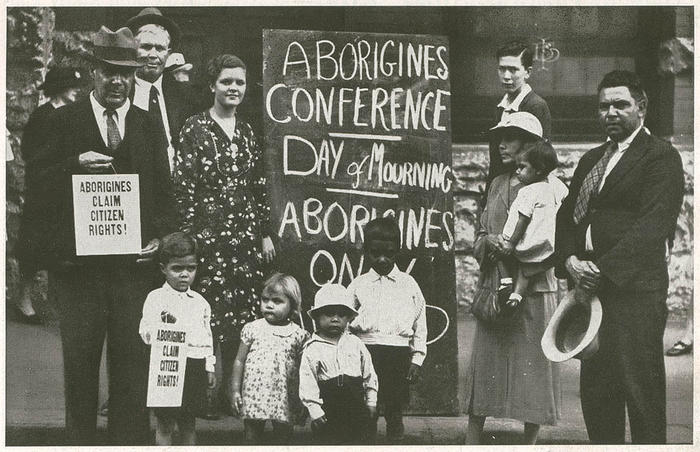Two things to ruminate on before and after reading this article:
- If you’re sharing the voices of First Nations people on your social media across the month of January, think about whether you’re amplifying the voices of Aboriginal and Torres Strait Islander peoples and the issues that affect us after January 26. Your First Nations family, friends and co-workers know when you’re sharing something just because it’s trending.
- Are you supportive of the Uluru Statement of the Heart and a constitutionally enshrined Voice to Parliament? If you’re nodding yes, then it’s important that you’re ok with being uncomfortable with First Nations people asking Australians to understand that our national identity, and the history that sits behind that identity, is contested. These lands were invaded not settled. Colonisation still affects us. Our history is full of terrible crimes against First Nations peoples, and it all started on January 26, 1788. This is not something to play devil’s advocate over when it comes to talking about Australia Day.
So, Invasion Day/ Survival Day/ Day of Mourning/ January 26/ Australia Day? To change the date or abolish the date?
A quick history lesson:
The 11 ships making up the First Fleet didn’t actually arrive to the shores of what we now call Australia on January 26, 1788. In fact, they arrived in Botany Bay around January 20. After deeming that Botany Bay wasn’t suitable for a landing, the Fleet made their way to Port Jackson around January 25. Then on January 26, Captain Arthur Philip, a few marines and officers disembarked their vessels, made their way onto the shore, raised the British flag and declared this land in the name of King George III. The planting of the Union Jack signified the invasion of the British on First Nations peoples and their lands, and marked the beginning of colonisation, dispossession, violence, and genocide.
A timeline of Australia Day:
Prior to Federation in 1901, New South Wales was the only colony that celebrated the anniversary of January 26. The date was honoured under various names such as Anniversary Day, Foundation Day, or First Landing Day.
The first official national day that was referred to as Australia Day took place on July 30, 1915. The day was held to raise funds for Australian soldiers and their efforts throughout the Gallipoli campaign. In the following year, an Australia Day committee was formed and on July 28 another Australia Day was held to raise money for the war effort.
It wasn’t until 1935, that all states and territories celebrated January 26 together, calling it Anniversary Day or Foundation Day. In 1946, the Federal and state governments agreed to unify Australia Day celebrations with all states and territories observing a public holiday on the Monday closest to January 26. But it wasn’t until 1994 that Australia Day was declared an official public holiday on January 26.
How do First Nations people refer to January 26?
For many First Nations people, January 26 is known as Invasion Day or Survival Day. These names for January 26 are to refer to the invasion of the British on our people and Country, and the subsequent and ongoing effects of colonisation since 1788. There is power in the reference Survival Day because despite coloniser efforts to oppress and erase us, we are still here, and we have survived.
For many First Nations communities across Australia, January 26 is also a Day of Mourning. In 1938, Jack Patten, William Ferguson, William Cooper along with the Australian Aborigines League (AAL), declared January 26 a Day of Mourning and led a march from Town Hall to Australia Hall in Sydney in protest of the 150-year anniversary of the landing of the First Fleet. Approximately 100 people attended, marking the gathering as the first mass Aboriginal civil rights protest. The AAL delivered their manifesto 'Aborigines Claim Citizen Rights!' and voiced “WE, representing THE ABORIGINES OF AUSTRALIA, assembled in conference at the Australian Hall, Sydney, on the 26th day of January, 1938, this being the 150th Anniversary of the Whiteman's seizure of our country, HEREBY MAKE PROTEST against the callous treatment of our people by the white men during the past 150 years, AND WE APPEAL to the Australian nation of today to make new laws for the education and care of Aborigines, we ask for a new policy which will raise our people TO FULL CITIZEN STATUS and EQUALITY WITHIN THE COMMUNITY.”
Change the date or abolish the date?
Each year many First Nations people attend protests and rallies to remind Australia that January 26 is not a day to be celebrated. Across these events it is not uncommon to hear the echoes of chants like “always was, always will be”, “still here”, and “white Australia has a black history”. The power and weight of our voices on the celebration of Australia Day has resulted in more and more non-Indigenous Australians becoming more mindful of what they’re doing on January 26.
The Change the Date movement calls for Australia Day to be celebrated on a different day. Followers of this movement believe that it is important for Australia as a nation to celebrate the achievements of our country and the lifestyle we enjoy.
However, many First Nations people believe that merely changing the date doesn’t address the atrocities, pain and suffering that has been inflicted on First Nations people since 1788. The Abolish the Date movement calls to cancel Australia Day altogether and argues that without acknowledgement of the true history of Australia or making significant changes to improve the lived experiences of all First Nations people in this country, Australia Day is rendered obsolete.
So, what next?
To show your support for First Nations people on January 26 you can:
- Attend an Invasion Day/ Survival Day rally or event
- Share and promote voices of First Nations people across social media platforms throughout the year
- Learn and understand the truth about our national history
- Start a conversation with your family, friends, or co-workers about the impacts of January 26 on First Nations people
- Read or watch a documentary that details the history and effects of colonisation on First Nations people
- Listen to First Nations artists
- Donate to First Nations causes
- Speak out and be political beyond January 26
Rethinking January 26 is important to the processes of truth-telling and driving change. What will you do this January 26?





